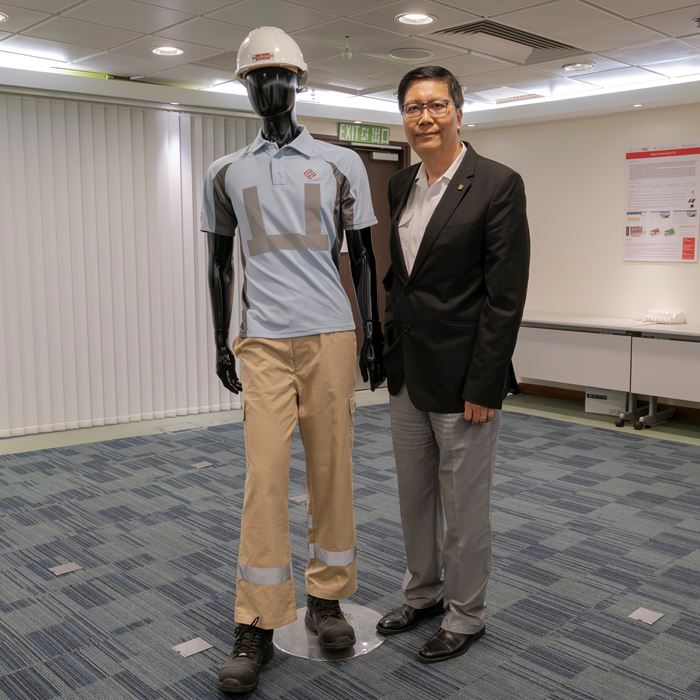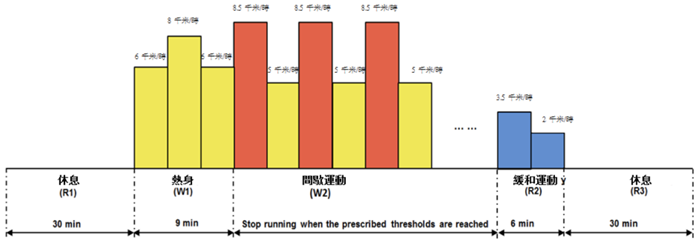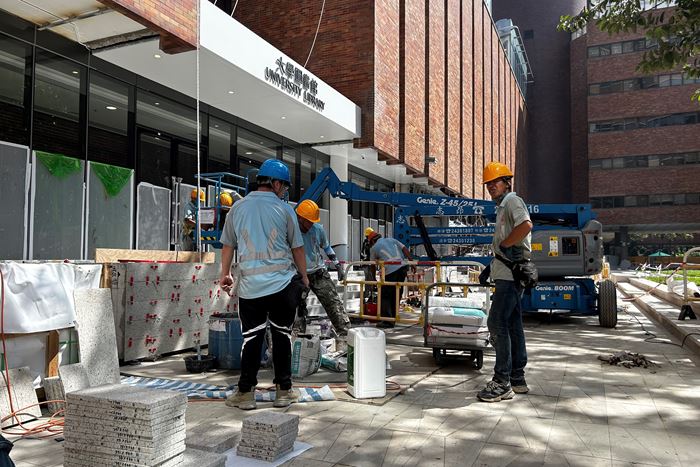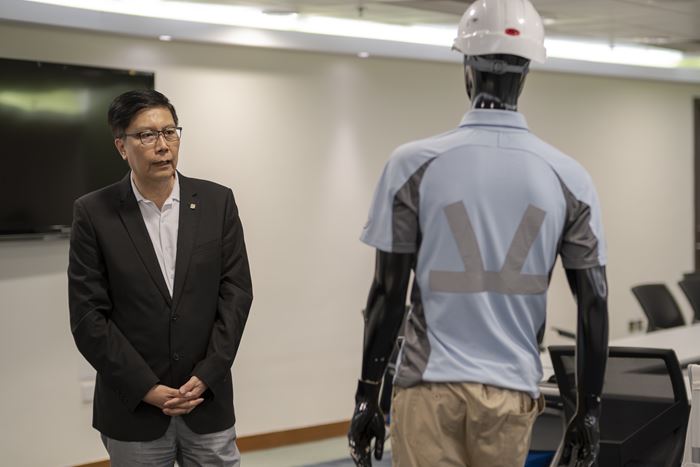Multi-functional Heat-resistant Clothing: Scientific Research Changes the Ecology of the Construction Industry
The summer weather in Hong Kong is hot and humid. According to data from the Occupational Safety and Health Council, outdoor work-related cases posing life-threatening risks due to extreme heat have been on the rise in recent years.

The second-generation heat-resistant clothing developed by Professor Chan embodies both comfort and functionality. It has received multiple awards, including Gold Medal at The 44th Geneva International Exhibition of Inventions in 2016, Invention & Innovation CAI Award (China Delegation) in 2016, CIOB International Innovation & Research Awards 2015, the Local Grand Prize of CIC Innovation Award 2015, Hong Kong Institute of Project Management Awards 2015, and Dean's Award for Outstanding Achievement in Technology Transfer 2015.
Construction workers often have to work under the scorching sun for extended periods; thus, various cooling measures are vital to ensure their safety at work.
To this end, Ir Professor Albert Chan, Dean of Students, Associate Director of Research Institute for Sustainable Urban Development, Able Professor in Construction Health and Safety, and Chair Professor of Construction Engineering and Management at the Department of Building and Real Estate of The Hong Kong Polytechnic University (PolyU), collaborated with the Construction Industry Council (CIC) to conduct research focusing on cooling, sweat evaporation and functionalities, so as to develop the latest technology and materials for heat-resistant clothing for use in the construction industry. The initiative aims to enhance the comfort and safety of construction workers working under hot weather.
Interdisciplinary Material Database and Smart Fabric Selector
In order to find suitable materials for production, Professor Chan's team utilises a multi-criteria evaluation system to understand the characteristics of different materials, including thickness, moisture-wicking capability, weight, and other data, enabling a preliminarily screen for the appropriate combination of materials for heat-resistant clothing.
Subsequently, the team conducts laboratory testing for each material, ensuring that the parameters of material characteristics meet the requirements. They then utilise the Smart Fabric Selector developed by PolyU to simulate the creation of garment prototypes with the desired qualities by combining fibres of different materials. "After testing over 30 material combinations, the most optimal result is finally achieved."
A Design that is Data-driven and Human-centred
In order to make workers "fall in love" with this garment, Professor Chan understands that the workwear design cannot solely rely on objective data of materials. It is also necessary to think from the users' perspectives and come up with a design that meets their practical needs. To achieve this goal, the team collaborated with the CIC and conducted interviews with over a hundred workers.
"We found that older workers tend to wear long-sleeved tops to avoid the scorching sun, while younger workers prefer to go shirtless which keep them cooler in heat but also increases the risk of skin cancer." These interesting findings not only help the team better understand the application of materials but also enable them to design heat-resistant workwear with different functionalities.
"We changed the workwear to a lake-blue colour that resists ultraviolet light effectively, while the inner lining uses mesh fabric to aid in heat dissipation, with breathable membranes added under the armpits. Ventilation holes are also incorporated into the retroreflective strips on the front and back to facilitate heat dissipation." In addition, the team introduced Coolmax fabric and materials with nano-components, which not only provide excellent breathability but also use capillary action. Sweat can only move upward to the surface of the fabric, preventing heat from being trapped inside the clothing. The outer layer of the fabric is super water-absorbing and quick-dry, facilitating rapid absorption of sweat and drying quickly through gentle airflow.
"The loose and well-fitting design of the heat-resistant clothing allows for mobility and enhances comfort. Pockets are equipped on both sides of the trousers to provide convenience for tool placement, combining comfort and functionality."
Climatic Simulation Laboratory Running Test
After creating the prototype of the heat-resistant clothing, the team invited the participating workers to undergo a "Climatic Simulation Laboratory Running Test" to validate the functionality of the heat-resistant clothing.

Workers participating in the "Climatic Simulation Laboratory Running Test" are required to perform a series of warm-up exercises and intermittent running to validate the functionality of the heat-resistant clothing.
The workers first warmed up in a sealed laboratory set at 34.5°C and 75% relative humidity, and then rested for 30 minutes in the environmental control room before proceeding to the laboratory for warm-up exercises and intermittent running. During the test, the workers had to engage in extreme physical activities intermittently to evaluate the performance of the heat-resistant clothing.
The research findings revealed that compared to traditional uniforms, the heat-resistant clothing effectively reduced physiological heat stress by 16.7% and heat storage rate by 28.8%. It also exhibited superior function to absorb sweat compared to cotton. Furthermore, the core body temperature, heat storage rate, and skin temperature of workers wearing the heat-resistant clothing were lower compared to those wearing traditional workwear.
Nominal Fee Charged Conducive for Continual Improvement

PolyU also supports the experiment by allowing construction workers on campus to wear the heat-resistant clothing and experience the favourable results emerging from the scientific research.
As for now, PolyU’s technology for developing the heat-resistant clothing is being licensed to the CIC for a nominal fee of HK$1. "Having a background in the construction industry myself, I certainly want to contribute to the industry. I strongly lobbied the University to agree to this approach, as I believed it was a means to achieve popularisation of heat-resistant clothing and benefit Hong Kong people," said Professor Chan.
In addition, this approach not only helps promote the widespread use of the heat-resistant clothing but also allows PolyU to obtain data from the CIC for continual improvement of materials and design.
"After the launch of the first-generation heat-resistant clothing, many workers were eager to provide their valuable feedback. For example, they requested materials that reduce body odour be included. We also improved the design of the retroreflective strips, making it easier to distinguish whether the worker is facing towards or away from the front from a distance." As a result of the streamlined procurement processes, the current price for the heat-resistant clothing is very affordable: around HK$58 for the top and HK$75 for the trousers.
When asked about the commercial value and potential market of the heat-resistant clothing, Professor Chan believes that this technology can be introduced to other industries where outdoor work is required.
For now, heat-resistant clothing is quite commonly used in the construction industry in both Government and private sector in Hong Kong. Since 2018, the Government has included in the tendering terms for construction projects that workers are required to wear heat-resistant clothing or clothing with equivalent performance.
According to the latest research, 87% of construction industry workers prefer to wear the heat-resistant clothing developed by PolyU.

The heat-resistant clothing features different retroreflective strips on the front and back, allowing the workers' front and back to be easily distinguished from a distance.

Professor Chan, with a background in the construction industry, hopes the industry could benefit from the widespread adoption of heat-resistant clothing.
